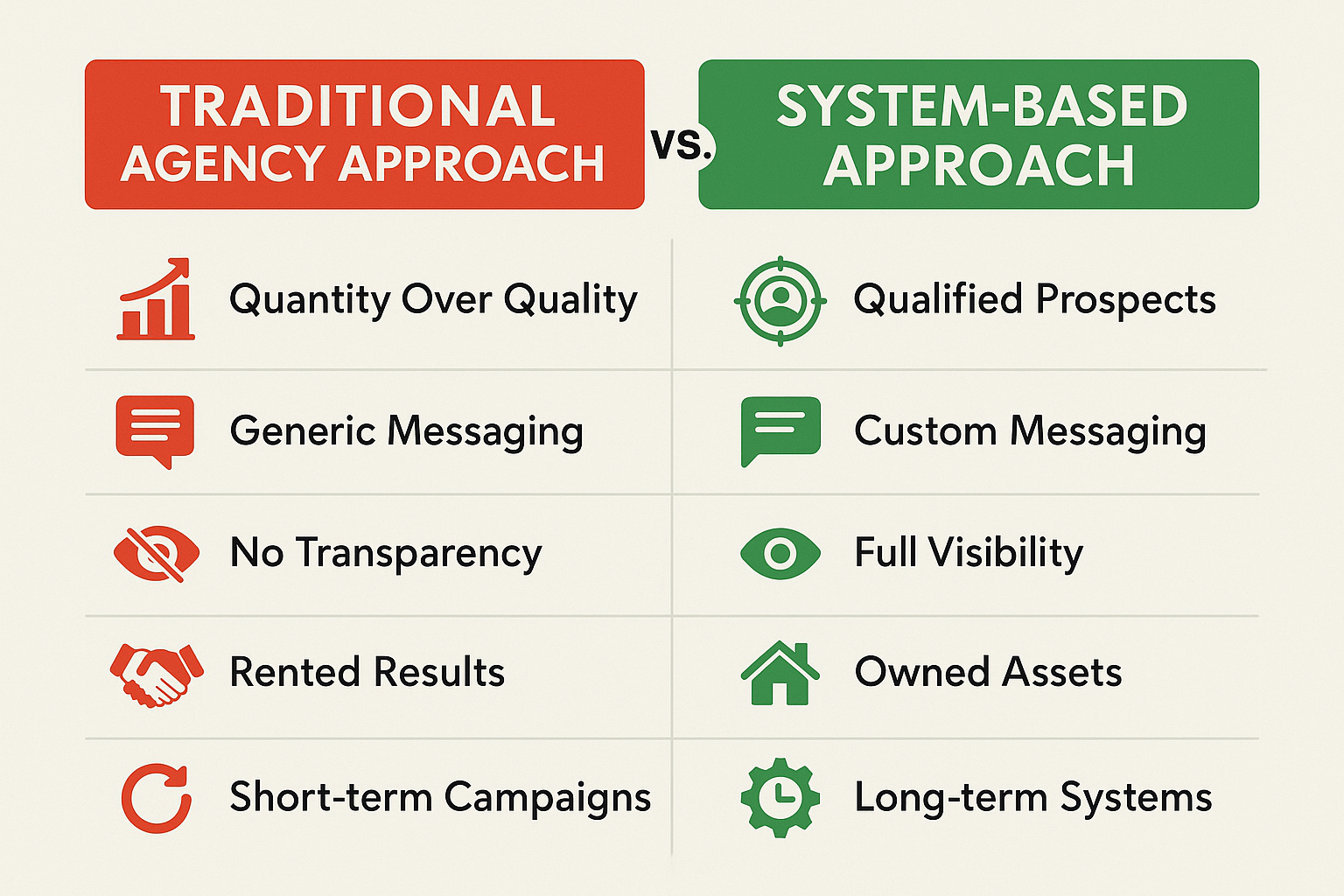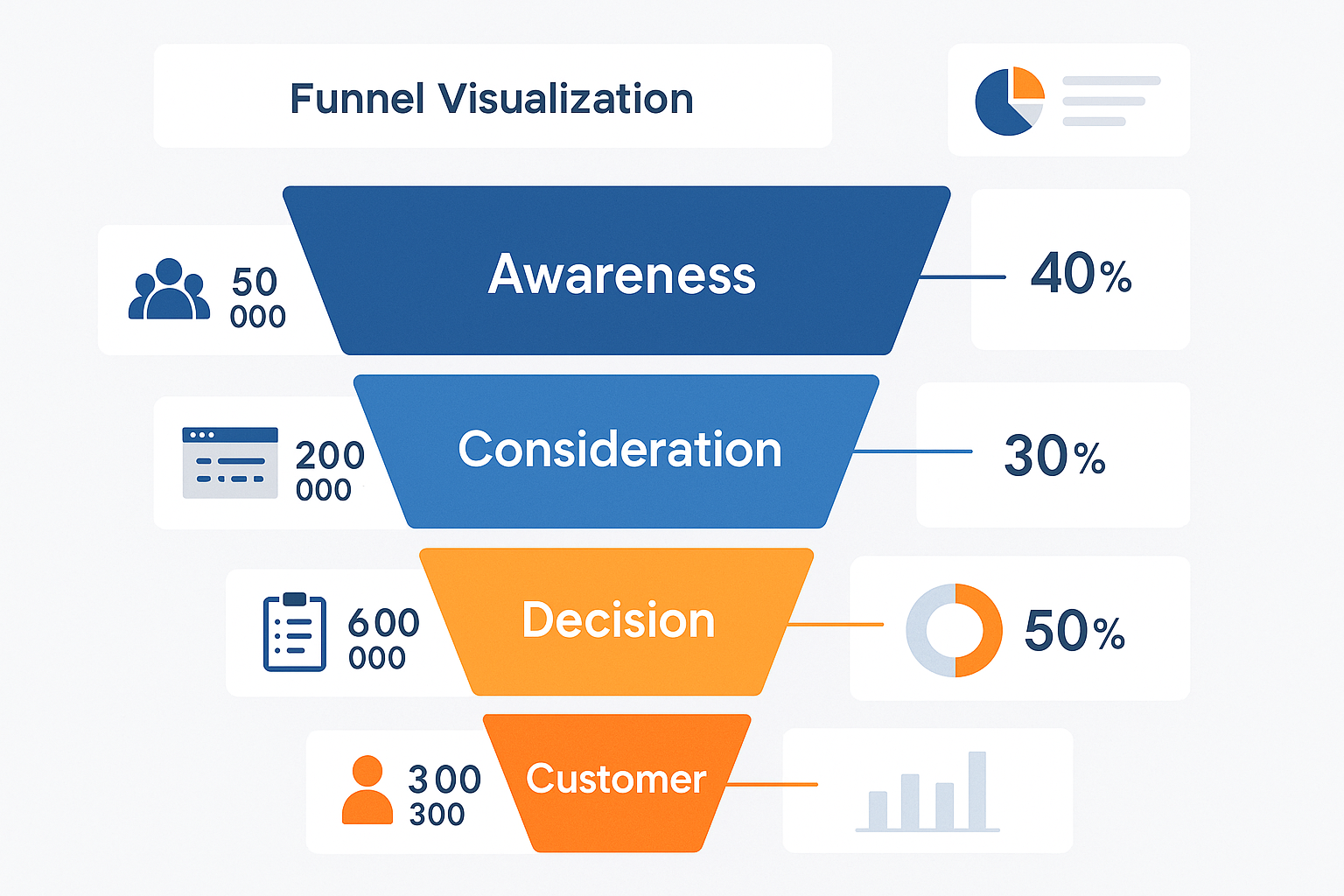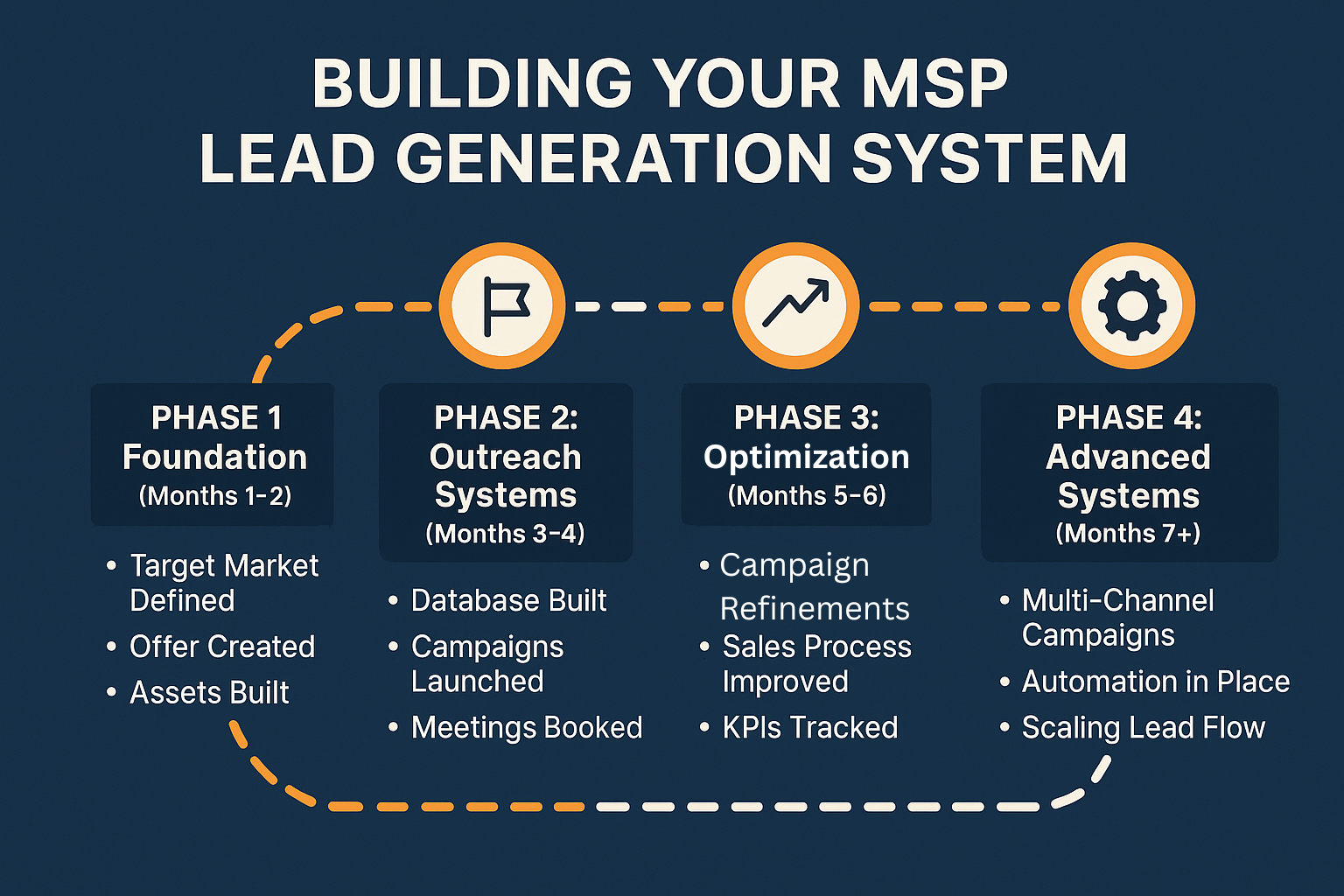Stop Wasting Money on Useless MSP Lead Gen Agencies

Picture this: You’ve just signed a check for $5,000 to another “guaranteed results” MSP lead generation agency. They promised 20 qualified appointments this month. Instead, you got 3 no-shows, 2 tire-kickers asking about $50/month basic email support, and one prospect who thought MSP stood for “My Sister’s Printer.” Sound familiar?
If you’re nodding your head right now, you’re not alone. I’ve talked to hundreds of MSP owners who’ve been burned by lead gen agencies that overpromise and underdeliver. The frustration is real, the wasted money adds up, and worst of all, you’re left wondering if there’s a better way to grow your business.
Here’s the truth: Most MSP lead generation agencies are fundamentally broken. They’re built on outdated models that treat your prospects like numbers in a spreadsheet rather than business owners with real problems that need solving.
Why Traditional MSP Lead Gen Agencies Keep Failing You

The Quantity Over Quality Problem
Let me tell you about Jake, an MSP owner from Denver who hired three different agencies over two years. Each one bragged about their “volume approach” of hundreds of emails, thousands of cold calls, and massive LinkedIn outreach campaigns.
The results? Jake got plenty of appointments. The problem was that 90% of them were with companies that either:
- Had no budget for IT services
- We’re happy with their current provider and are just being polite
- Needed basic consumer-level support, not enterprise MSP services
- We weren’t decision-makers and couldn’t buy anything
Traditional agencies get paid for appointments booked, not deals closed. This creates a massive misalignment where they’re incentivized to book as many meetings as possible, regardless of quality.
The real cost isn’t just the agency fee; it’s your time. Every bad appointment is 30-60 minutes you could have spent:
- Working with existing clients
- Improving your services
- Building real relationships
- Running your business
They Don’t Understand MSP Sales Cycles
Here’s where most agencies completely miss the mark: MSP sales cycles are complex, relationship-driven, and can take 3-18 months to close.
A typical agency approach looks like this:
- Send a cold email
- Book an appointment for next week
- Hand off lead to MSP
- Expect an immediate close
- Move on to the next prospect when it doesn’t happen
But here’s how MSP sales work:
- Initial contact and problem identification
- Trust-building phase (multiple touchpoints)
- Technical assessment and proposal
- Stakeholder buy-in and decision-making
- Contract negotiation
- Implementation planning
- Finally – contract signing
Most agencies give up after step 3 because they don’t have systems for long-term nurturing. They’re built for quick wins, not the patient relationship-building that MSP sales require.
Generic Messaging That Screams “Mass Marketing”
I recently saw an email template from a popular MSP lead gen agency. It started with: “Hi [FIRST_NAME], I noticed your company [COMPANY_NAME] and thought you might be interested in our cybersecurity solutions…”
Prospects aren’t stupid. They can spot templated, mass-market messaging from a mile away. When your outreach sounds like it could be sent to any business in any industry, you’ve already lost.
Effective MSP marketing requires:
- Industry-specific pain points and solutions
- Company size-appropriate messaging
- Regional relevance and local market understanding
- Technology stack awareness and compatibility
- Compliance requirement knowledge for their sector
Generic agencies can’t deliver this level of customization because they’re working with dozens of MSPs across different markets, industries, and specializations.
The Transparency Problem: Flying Blind on Your Marketing
Black Box Reporting
How many times have you asked your lead gen agency for detailed reporting and received something like this:
- “Emails sent: 2,847”
- “Open rate: 23%”
- “Appointments booked: 7”
- “Pipeline value: $45,000”
That’s not reporting – that’s vanity metrics. Real transparency means knowing:
- Which specific companies were contacted, and why
- What messaging was used for each prospect segment
- How prospects responded at each stage of outreach
- Why didn’t it convert to proposals
- What feedback prospects gave during discovery calls
- Which follow-up sequences are working
Most agencies resist this level of transparency because it would expose how little strategic thinking goes into their campaigns.
No Real Funnel Ownership
Here’s the scariest part: When you work with traditional lead gen agencies, you don’t own anything.
- They control the email sequences
- They own the prospect data
- They manage the follow-up systems
- They decide the messaging strategy
What happens when you stop paying them? Everything disappears. All those prospects in your “pipeline”? Gone. The email sequences that were “working”? Inaccessible. The data about what messaging resonates with your market? Locked away.
You’re essentially renting your marketing system instead of building an asset that grows your business long-term.
The “System vs. Sprint” Approach: Building Sustainable Growth
Why MSPs Need Systems, Not Campaigns
I learned this lesson the hard way when I was running my first MSP. We’d hire an agency, see a spike in leads for 2-3 months, then watch everything crater when the campaign ended or the agency moved on to “newer strategies.”
Sustainable MSP growth requires building systems that compound over time:
- Content that establishes expertise and attracts prospects organically
- Email nurture sequences that build relationships over months
- Referral systems that turn clients into advocates
- Process documentation that makes every interaction consistent
- Data collection that improves targeting over time
Think of it like this: Campaigns are like renting leads. Systems are like buying real estate that appreciates in value.
End-to-End Funnel Visibility
Real growth happens when you can see and optimize every step of your prospect’s journey:
Awareness Stage:
- How are prospects finding you?
- Which content pieces drive the most engagement?
- What problems are they researching?
Consideration Stage:
- Which nurture sequences move prospects forward?
- What objections come up most frequently?
- How long does it typically take to build trust?
Decision Stage:
- What factors influence final buying decisions?
- Which proposal elements are most compelling?
- How can you shorten the sales cycle?
Customer Stage:
- Which clients become advocates?
- What services lead to the highest satisfaction?
- How can you increase lifetime value?
Traditional agencies only focus on the first stage, getting attention. They hand off prospects and hope for the best. A systematic approach optimizes every stage for maximum conversion and long-term value.
Human-Feeling Automation: The Sweet Spot Between Scale and Personalization
Why “Set It and Forget It” Doesn’t Work for MSPs
MSP prospects are sophisticated business owners who can spot automated marketing from a mile away. But that doesn’t mean automation is bad; it means your automation needs to feel human.
Here’s what human-feeling automation looks like:
Bad Automation:
“Hi [FIRST_NAME], are you tired of IT problems costing your [COMPANY_TYPE] money? Click here to schedule a call!”
Human-Feeling Automation:
“Hi Sarah, I noticed TechCorp recently expanded to a second location in Austin. Managing IT across multiple sites can be tricky, especially when you’re trying to maintain security standards. I helped a similar manufacturing company solve this exact challenge last year. Would it be worth a brief conversation to share what worked for them?”
The difference? Context, specificity, and genuine value.
Building Automation That Converts
Effective MSP automation requires multiple layers:
Research Layer:
- Industry-specific triggers and events
- Company growth indicators
- Technology stack analysis
- Compliance requirement mapping
Messaging Layer:
- Segment-specific pain points
- Industry-relevant case studies
- Local market references
- Appropriate technical depth
Timing Layer:
- Business cycle awareness
- Seasonal considerations
- Industry event alignment
- Follow-up sequence optimization
Personalization Layer:
- Individual role customization
- Company size adjustments
- Geographic relevance
- Previous interaction history
This level of sophistication requires dedicated systems and processes, not something a generalist agency can deliver while managing dozens of other clients.

Brand Consistency: Building Trust That Converts
Why Your Brand Can’t Be an Afterthought
Here’s something most MSP owners don’t realize: Your prospects research you long before they ever take a sales call.
They’re looking at:
- Your website and content quality
- Your social media presence
- Your Google reviews and reputation
- Your thought leadership and expertise
- Your client testimonials and case studies
When agencies handle your outreach with generic messaging and templates, there’s a massive disconnect between the professional, polished brand you’ve built and the mass-market approach they’re using to represent you.
I’ve seen MSPs lose deals not because their technical capabilities weren’t good enough, but because the prospect’s first impression came from a poorly written cold email that made the MSP look unprofessional.
Owning Your Brand Message
Effective MSP marketing requires complete alignment between your outreach, your content, your sales process, and your service delivery.
Your messaging should reflect:
- Your unique value proposition
- Your ideal client profile
- Your service methodology
- Your company personality
- Your market positioning
This consistency builds trust because prospects see the same professional, competent organization at every touchpoint. They’re not surprised when they meet you; they’re confident they’ve found the right partner.
Traditional agencies can’t deliver this because they’re trying to represent multiple MSPs with different strengths, markets, and approaches. You need systems that are built specifically for your business.
The MSP Hub HQ Difference: Systems That Scale
Beyond the Agency Model
After watching hundreds of MSPs struggle with traditional lead gen agencies, we built something different at MSP Hub HQ. Instead of renting you leads, we help you build systems that generate qualified prospects month after month.
Here’s how our approach differs:
Traditional Agencies:
- Focus on quantity metrics
- Use generic messaging
- Provide limited transparency
- Control your marketing assets
- Deliver short-term campaigns
MSP Hub HQ Systems:
- Prioritize qualified prospect quality
- Create custom messaging for your market
- Provide complete funnel visibility
- Help you own your marketing assets
- Build long-term growth systems
Complete Funnel Ownership
When you work with us, you own everything:
- Custom email sequences built for your ideal clients
- Prospect databases that you control and access
- Content systems that establish your expertise
- Follow-up processes that nurture long-term relationships
- Analytics and reporting that show exactly what’s working
This isn’t a service you rent – it’s a system you own.
Human-Feeling Automation at Scale
Our approach combines the efficiency of automation with the personal touch that MSP prospects expect:
- Industry-specific research that identifies qualified prospects
- Custom messaging that speaks to real business problems
- Multi-channel outreach that builds relationships over time
- Intelligent follow-up that adapts based on prospect behavior
- Seamless handoffs that maintain momentum through your sales process
What Real MSP Lead Generation Success Looks Like
Quality Metrics That Matter
Instead of celebrating vanity metrics like “emails sent” or “calls made,” successful MSP lead generation focuses on:
Qualified Prospect Metrics:
- Prospects with appropriate budget ranges
- Decision-makers or strong influencers
- Companies with genuine IT challenges
- Businesses in your target market segments
Relationship Building Metrics:
- Response rates to follow-up communications
- Engagement with your content and resources
- Referrals from existing prospects
- Time from first contact to proposal request
Business Impact Metrics:
- Average deal size from generated leads
- Client lifetime value from marketing-sourced prospects
- Cost per acquisition vs. client value
- Marketing ROI over 12-24 month periods
Long-Term Asset Building
Successful MSP marketing builds assets that appreciate over time:
- Content libraries that establish expertise and attract prospects
- Email lists of engaged prospects and referral sources
- Referral networks that generate consistent introductions
- Reputation systems that build trust and credibility
- Process documentation that improves results with every iteration
These assets become more valuable as they grow, creating compound returns on your marketing investment.
Red Flags: How to Spot Agencies That Will Waste Your Money
Promises That Are Too Good to Be True
Run away from agencies that guarantee:
- Specific numbers of appointments in unrealistic timeframes
- “Guaranteed ROI” without understanding your business model
- “Exclusive territories” that don’t exist
- “Done-for-you” solutions that require zero input from you
Real MSP marketing requires collaboration between the agency and your team. Anyone promising results without understanding your business, your market, or your ideal clients is selling you a fantasy.
Lack of MSP-Specific Experience
Generic B2B lead gen agencies often claim they can work with MSPs because “business is business.” This is completely wrong.
MSP marketing requires understanding:
- Complex technical concepts and how to communicate them to non-technical buyers
- Compliance requirements across different industries and regulations
- Service delivery models and how they impact pricing and positioning
- Competitive landscapes and differentiation strategies
- Client retention dynamics and lifetime value calculations
Ask potential agencies for specific MSP case studies and references. If they can’t provide detailed examples of MSP success stories, look elsewhere.
No Clear Process for Lead Qualification
If an agency can’t explain exactly how they qualify prospects before booking appointments, that’s a massive red flag.
Effective lead qualification includes:
- Budget verification through research and discovery questions
- Decision-maker identification and stakeholder mapping
- Timeline assessment and project urgency evaluation
- Current situation analysis and pain point identification
- Fit assessment based on your ideal client profile
Agencies that book appointments without qualification are essentially charging you to do their job for them.
Building Your Own Sustainable Lead Generation System
Start with Foundation Elements
Before you can build effective lead generation, you need solid foundations:
Clear Ideal Client Profile:
- Industry verticals and company sizes
- Geographic markets and service areas
- Technology environments and complexity levels
- Budget ranges and decision-making processes
- Current pain points and growth challenges
Compelling Value Proposition:
- Unique strengths and differentiators
- Specific problems you solve best
- Measurable outcomes you deliver
- Why prospects should choose you over competitors
Content Strategy:
- Educational resources that demonstrate expertise
- Case studies that prove your capabilities
- Thought leadership that builds trust
- Tools and resources that provide immediate value
Implementation Roadmap
Phase 1: Foundation (Months 1-2)
- Define ideal client profiles and messaging
- Create core content and case studies
- Set up tracking and analytics systems
- Build initial prospect databases
Phase 2: Outreach Systems (Months 3-4)
- Develop email sequences and follow-up processes
- Create multi-channel outreach campaigns
- Implement lead scoring and qualification systems
- Train team on new processes
Phase 3: Optimization (Months 5-6)
- Analyze performance data and optimize messaging
- Expand successful campaigns to new segments
- Build referral and advocacy programs
- Scale systems based on what’s working
Phase 4: Advanced Systems (Months 7+)
- Implement marketing automation and lead nurturing
- Create content marketing and SEO strategies
- Build partnership and alliance programs
- Develop retention and expansion systems

The True Cost of Bad Lead Generation
Beyond the Agency Fees
When you calculate the real cost of working with ineffective lead gen agencies, the numbers are staggering:
Direct Costs:
- Monthly agency retainers ($3,000-$8,000+)
- Set-up fees and onboarding costs
- Additional tools and software requirements
Hidden Costs:
- Time spent on unqualified appointments (20-40 hours/month)
- Opportunity cost of not working with qualified prospects
- Team frustration and decreased productivity
- Damage to brand reputation from poor outreach
Long-Term Costs:
- No owned assets or systems to show for investment
- Continued dependence on external agencies
- Lack of market intelligence and prospect data
- Missing opportunities to build sustainable growth systems
For most MSPs, the hidden and long-term costs are 3-5x higher than the direct agency fees.
The Compound Value of Owned Systems
When you build your lead generation systems, the value compounds over time:
Year 1: Initial investment in systems and processes
Year 2: 50-100% improvement in efficiency and results
Year 3: 200-300% improvement as systems mature and optimize
Year 4+: Exponential returns as reputation, content, and referrals accelerate growth
This is why successful MSPs eventually move away from rented lead generation and invest in building their sustainable systems.
🔍 MSP Lead Gen Agency Evaluation Tool
Answer these questions to assess if your current agency is delivering real value
Making the Switch: From Agency Dependence to System Ownership
Transition Planning
If you’re currently working with an underperforming agency, don’t just cancel the contract tomorrow. Smart MSPs plan their transition to minimize disruption:
30 Days Before Transition:
- Document what’s currently working (if anything)
- Export any data or assets you can access
- Begin building your ideal client profiles and messaging
- Start creating foundational content and case studies
During Transition:
- Gradually reduce agency dependence
- Implement your tracking and analytics
- Begin testing new outreach approaches
- Train your team on new processes
30 Days After Transition:
- Analyze performance differences
- Optimize based on early results
- Scale successful approaches
- Continue building long-term assets
Investment vs. Expense Mindset
Traditional agencies are an expense you pay monthly fees for temporary results that disappear when you stop paying.
Building your systems is an investment you pay upfront to create assets that generate returns for years.
Most MSPs spend $36,000-$96,000 annually on lead gen agencies. That same investment could build comprehensive marketing systems that:
- Generate higher-quality prospects
- Build your brand and reputation
- Create owned assets and databases
- Provide complete transparency and control
- Deliver compound returns over time
Real Success Stories: MSPs Who Made the Switch
Case Study: TechGuard Solutions
The Problem: TechGuard worked with three different agencies over 18 months, spending over $75,000 with minimal results. They were getting 15-20 appointments per month, but closing less than 5% of them.
The Solution: They invested in building their systems with industry-specific messaging, long-term nurture sequences, and complete funnel ownership.
The Results:
- Reduced monthly appointments to 8-10, but increased close rate to 35%
- Average deal size increased from $2,500 to $8,500
- Built an email list of 2,400 qualified prospects
- Generated $340,000 in new revenue in year one
- ROI improved by 450% compared to the agency approach
Case Study: Midwest IT Partners
The Problem: Midwest IT was spending $5,500/month with an agency that promised “guaranteed appointments.” They were getting appointments, but with companies that had $500/month budgets when their minimum engagement was $3,000/month.
The Solution: They shifted to a system-based approach focused on mid-market manufacturers in their region, with deep industry expertise and case studies.
The Results:
- Qualified prospect quality improved dramatically
- Average sales cycle shortened from 8 months to 4 months
- Built strategic partnerships with 3 local business organizations
- Developed thought leadership content that generates 15-20 inbound leads monthly
- Reduced cost per acquisition by 60% while doubling deal sizes
Your Next Steps: Building a Better Lead Generation Future
Immediate Actions (This Week)
- Audit your current agency performance using the evaluation criteria in this article
- Calculate your true cost per qualified prospect, including time and opportunity costs
- Document what you own from your current marketing investments
- Identify gaps between your brand and your agency’s representation
Short-Term Planning (Next 30 Days)
- Define your ideal client profile with specific criteria and characteristics
- Develop your unique value proposition and competitive differentiators
- Create foundational content, including case studies and thought leadership
- Research system-based alternatives to traditional agency models
Long-Term Strategy (Next 90 Days)
- Build your transition plan for moving away from agency dependence
- Invest in owned systems that generate compound returns over time
- Implement tracking and analytics for complete funnel visibility
- Start creating content and nurture sequences that build long-term relationships
Conclusion: Stop Renting Growth, Start Building Assets
The MSP industry has evolved, but most lead generation agencies haven’t kept up. They’re still using outdated approaches that prioritize quantity over quality, offer no transparency, and leave you with nothing to show for your investment when the contract ends.
You have a choice: Continue renting temporary results from agencies that don’t understand your business, or invest in building systems that generate qualified prospects month after month while building your brand and reputation.
The MSPs that thrive over the next decade will be the ones who own their growth systems rather than renting them. They’ll have complete visibility into their marketing funnels, own their prospect data and messaging, and build assets that appreciate over time.
If you’re tired of wasting money on agencies that don’t deliver, it’s time to explore a different approach. The question isn’t whether you can afford to build your systems, it’s whether you can afford not to.
Your prospects are out there, looking for an MSP they can trust. Make sure they find the real you, not some generic version created by an agency that doesn’t understand your market.
The future of MSP growth belongs to those who build systems, not those who buy campaigns. Which path will you choose?
Ready to stop wasting money on ineffective lead generation? Learn more about building sustainable MSP growth systems that you own and control. Book a consultation to discover how successful MSPs are generating qualified prospects without depending on traditional agencies.
Related Reading: Discover how to use Google My Business for MSPs: The Local Domination Strategy and establish your expertise in your target market.

